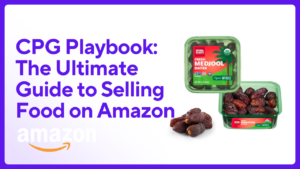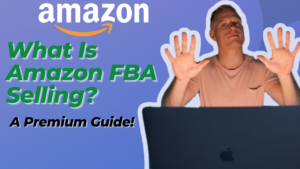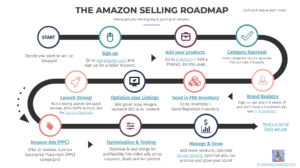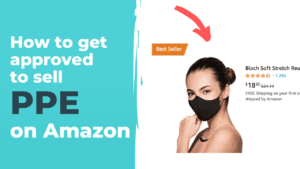If you’re planning on selling supplements on Amazon, you’ve chosen a great time to start.
The Amazon supplements niche is huge. With steady growth over the 2010s, the COVID-19 pandemic made this market explode, with Amazon surpassing Walmart, CVS, and Target as an online supplements marketplace.
Entering the Amazon supplements niche can be hugely profitable, but it’s no walk in the park. Aside from the strict approval requirements, you’ll need to ensure you have a functional seller account, well-optimized listings, and a strategy for quickly building momentum after launch.
In this ultimate guide, we’ll walk you through the crucial first steps of how to sell supplements on Amazon using our tried and proven S.A.L.E method, and show you how you can maximize your chances of success in this niche.
Selling Supplements on Amazon: The Why
Starting a supplements business on Amazon has a number of benefits over other product niches. Though it’s highly competitive, the supplements market has several upsides that can make it an attractive prospect to new Amazon sellers.
All of the successful supplements brands we’ve helped launch on Amazon have been able to enjoy:
- High LTV: Supplements have a markedly high life time value (LTV), which is the average revenue a single customer will generate over the course of their relationship with your business. Supplements, along with certain product niches like food and beverage or beauty, have much higher potential to generate a stream of repeat purchases compared to products that tend to be one-time purchases. This is why we emphasize to our clients that breaking even in the first year of your launch should be taken as a sign of success to come.
- Low start-up costs: Even the highest quality supplements have relatively low inventory costs, making supplements an attractive niche for new sellers who are bootstrapping or otherwise working with a low investment.
- Trust in Amazon’s Platform: Because supplements are directly related to the health of customers, you’ll need to generate a high level of trust before you start getting loyal repeat customers for your supplements business. While this can be a challenge when you’re selling through your own platform like an ecommerce website, selling on a trusted platform like Amazon will let consumers know that your products meet certain standards of safety and quality.
Amazon Supplement Requirements
As you can imagine, starting to sell supplements on Amazon isn’t as simple as creating an account and a listing. You’ll need to abide by certain policies set by Amazon in order to get your supplements business up and running.
Here are the key things you’ll need to consider when you’re looking at how to get approved to sell supplements on amazon:
Approval Documentation
There are two options you can use to source the minimum required approval documentation to sell supplements on Amazon.
Note that the required documentation can vary somewhat from one type of supplement to another. To find out what the exact requirements are for your products, be sure to check out the official Seller Central Guidelines.
- A valid certificate of good manufacturing practice (GMP) issued by a recognized third-party certifying authority in accordance with 21 CFR 111, 21 CFR 117, or both. Amazon accepts GMP certificates from third-party certifying authorities such as NSF/ANSI 455-2, NSF/ANSI 173 Section 8, GRMA 455-2, UL GMP, USP GMP, Eurofins, SAI Global, SGS, Intertek, TGA, and SSCI.
- Certificate of Analysis (COA) of declared dietary constituents issued by an ISO/IEC 17025 accredited laboratory or in-house laboratory located in the aforesaid facility and in accordance with current GMPs. For each ingredient included on the supplement facts panel, the COA must contain the product name, batch number, test results, and test methodologies.
Note: If you have one of these certifications, you don’t need the COA and GMP. Demonstration of product registration or involvement in any of the subsequent third-party quality certification initiatives is required: NSF/ANSI 173 Product Certification, NSF Certified for Sport®, BSCG Certified Drug Free®, Informed-Choice/Informed-Sport Program, USP Dietary Supplement Verification Program, or UL Brand Certification Program.
3. Product images of all six sides of the product, as well as a prominent view of the product’s name and the brand owner’s or manufacturer’s name and address. It is best to take these photos using a smartphone while the object is on a flat surface.
4. A copy of the manufacturer’s purchase order is required for documentation purposes.
Dietary Supplements Regulation
When selling supplements on Amazon or any other market, you’ll need to familiarize yourself with the relevant laws and regulations that apply to your product.
Here are a few key points to bear in mind when selling supplements on Amazon in the United States:
- The “dietary supplement” classification covers products such as vitamins, minerals, herbs, sexual improvements, weight control, and bodybuilding aids.
- Though the FDA does regulate supplements on the marketplace, a new supplement does not require FDA approval before it’s sold to the public. It’s the responsibility of the supplement companies themselves to make sure their products meet relevant safety standards.
- All dietary supplements are required to display certain pieces of information on their packaging, including a complete list of ingredients, the amount of ingredients per serving the serving size, and number of servings in the container or sold unit. The packaging must also feature a brief description that identifies it as a supplement, e.g “dietary supplement”, “calcium supplement”, etc.
Compliance Requirements
Amazon also requires any supplement products to adhere to certain industry regulations:
- Nutritional Labeling: Comply with 21 CFR 101.36 for nutritional labeling.
- Good Manufacturing Practices (GMP): Adhere to 21 CFR 111 for GMP in manufacturing, packaging, and labeling.
- Hazard Analysis: Follow 21 CFR 117 for Hazard Analysis and Risk-Based Preventative Controls (HARPC) for Human Food.
Additionally, if you’re planning to sell sexual enhancement or weight management supplements, you’ll need to provide:
- Evidence of involvement in a third-party quality certification program or a GMP certificate.
- A certified laboratory issued a certificate of analysis for each ingredient.
- Authentic photos of product labels and information about the brand.
Making sure your supplements are up to Amazon’s requirements can be hard work. For more support on getting your products approved, get in touch today.
Selling Supplements on Amazon: The S.A.L.E Method
Once you’ve made sure that your products are compliant with Amazon’s regulations, you’ll need to get your account set up, create a great listing, and market aggressively to start building traction after your launch.
Here are the steps required to get ready for your Amazon product launch, following the first three phases of our tried and tested S.A.L.E (Setup, Appearance, Launch, and Expand) method.
Setup: Getting Started
Step 1: Create a Seller Account

Create a seller account by visiting Seller Central, clicking “Create your Amazon Account”, and completing the setup instructions. You’ll need to submit some details about your business type and location, personal information, billing information, and product details.
Step 2: Apply to Un-gate the Supplements Category
As part of the listing process, you’ll need to apply to sell in the Vitamins & Dietary Supplements category. This is where Amazon will ask you to submit your cGMP certificate, COA, a manufacturer invoice, and any other relevant documentation.
Step 3: Submit Manufacturer / Distributor Invoice
Next, you’ll need to supply Amazon with an invoice from the manufacturer or distributor who supplies your supplements. This document needs to display your name and address (as shown when you set up your seller account) be less than 180 days old, and should show that you’ve purchased at least 10 units of your product.
Step 4: Upload Product Images
As part of the approval process, Amazon requires all sellers to submit images of the product they’re planning to sell. These need to be high-quality images of the product in its original packaging, with no editing whatsoever.
Once you’ve completed these steps, you’ll be ready to create your listing. This is where some of the most important work towards growing your business comes in.
Step 5: Get Brand Registry
Amazon brand registry helps to protect your intellectual property on the site and gives you access to some powerful features, such as a video content slot in your listing image gallery, A+ content, and a brand store. Though not strictly necessary to start selling supplements on Amazon, completing brand registry will be crucial to your success as a seller.
Appearance: Creating a Great Listing
You might have the best supplement in the world, but if you’re presenting it with a poor-quality listing, you’re not going to generate many sales.
A great Amazon listing needs to have quality copy backed by keyword research, and professional, engaging, and informative visual content.
Let’s take a look at each element of your product you’ll need to optimize for your Amazon product launch, and the steps you can take to maximize your chances of high rankings and conversion rates.
Listing Copy

Amazon listing copy covers the title, bullet points, and product description as shown on your product detail page.
Before we get into the best practices for each of these elements, a quick word about the importance of keyword research for Amazon SEO:
Like Google, Amazon’s search algorithm will crawl your product pages and use the presence of keywords to determine how relevant the product is to a shopper’s search query. Before you write your copy, you’ll need to get set up with a keyword research tool like Merchantwords or Jungle Scout, which will allow you to see the volume (average monthly searches) of keywords that are relevant to your supplement.
Use one of these tools to select keywords that get a high monthly volume, and that can be included naturally in your product copy.
Title (200 Characters)
The title is the first thing Amazon users will see of your supplement, so it’s crucial to get it right. Your product title should include your highest-volume keyword, and the most relevant information regarding your product, such as its key ingredients, its benefits, and its quantity or weight.
You should also try to emphasize your supplement’s key USP in the title and give your target audience a reason to click on your listing rather than the competitors also ranking for your keywords. Aside from improving your raw traffic, click-through rate is an Amazon ranking factor, and will improve your organic rankings over time.
Bullet Points (500 Characters Each)
Though your bullet points can be up to 500 characters each, it’s important to note that Amazon’s algorithm will stop crawling this element at 1000 characters, so we recommend aiming for around 200 characters for each bullet to ensure all your keywords are registered.
Each bullet should focus on a different feature of your supplement, and the benefit offered by this feature, for example: “High in Calcium: The high calcium content supports bone strength, dental health, and normal muscle and nerve function.”
Include further keywords you haven’t used in the title, but make sure these are done naturally and not forced in. The language must be natural and engaging to maximize the chances of a purchase, and crowbarring in keywords will only serve to create a jarring experience for your customers.
Product Description (2,000 Characters)
The products description is the longer text field that appears under the listing copy and A+ content. Though this isn’t as important for ranking and conversion as the title and bullets, Amazon’s algorithm will still crawl it for keywords.
This section should reiterate the information in your bullets in more detail, and include any branded language, keywords, and product details which you weren’t able to include naturally in the bullets.
Backend Keywords (250 Characters)
The back end keywords field isn’t visible on your published listing, and is provided for you to include other relevant keywords that weren’t covered in the visible elements. This is a great place for you to add any keywords that came up in your research that you weren’t able to include naturally while writing your copy.
A few important things to note about the back end keywords:
- You don’t need to separate words by commas, and doing so will only waste valuable characters.
- You can’t include any competitor brand names, unless they’re made up of common words, for example “green” or “life”. Doing this could lead to your listing being penalized by Amazon or taken down completely.
- Amazon’s algorithm doesn’t take keyword density into account. This means that you only need to include a keyword once in one of the crawlable fields to maximize the chances of ranking for that term. Because of this, there’s no need to repeat keywords in the backend that you’ve already covered, and doing so will only waste characters.
Images

Your listing images are one of the biggest predictors of how successful your product will be on Amazon, and you should ensure they’re of the highest quality possible. Here are some important best practices to bear in mind for Amazon listing images:
- Upload at least five images per listing. This is known to increase engagement and ranking.
- Make sure your images are at least 1000 pixels on the longest side. This enables users to zoom in on images. Ideally, your images should have a square 1:1 aspect ratio.
- Select images that show off all the visual details of your product, for example different angles of the packaging, what the actual pills or powder looks like, and so on.
- Create informative infographic-style content with text overlays that delve into your supplement’s ingredients and benefits. For supplements, we find that images comparing your product to popular alternatives in the same market perform especially well.
- Make sure your images are mobile-friendly with high-resolution graphics and large, easy-to-read text.
- Use lifestyle images that align with your product and target audience. For example, if your product is made to help with joint pain, you might want to source images of elderly people engaging in physical activity.
A+ Content

A+ content is the visual and text content that appears under the main listing and related products carousel. This allows you to create a better shopping experience by delving into more product details, tell the story of your brand, and overcome any last purchase barriers.
Furthermore, even though Amazon won’t crawl the keywords used in your A+ content, having it is known to be a positive ranking factor for your product listings.
Some of the crucial best practices for creating great A+ content include:
- Creating purpose-built visual assets for each different module you’re planning to use in the content. Amazon’s A+ content builder platform has specific image dimension requirements for different modules, and uploading images that match these exactly will ensure the finished result comes out looking professional and engaging.
- Visually explore the product USPs, for example through individual icons relating to the physical benefits of your supplement.
- Carry out thorough competitor research and use the content to distinguish your supplement from similar products on the market.
- Address your customers’ frequently-asked questions that haven’t been answered in the preceding copy.
- Like your listing images, make sure that every visual element is mobile-friendly and helps create a great shopping experience no matter what device your customers are using.
- Use the comparison chart module to introduce customers to other products in your range and drive traffic to other listings. If you don’t have other products in your range, be sure to tell your brand story in a compelling way that keeps your supplements business top-of-mind for undecided potential customers.
Making sure your content is up to a great standard while staying aligned with strict Amazon supplement requirements can be a challenge for any new seller. To find out how we can help you create top-quality content that maximizes engagement, talk to us today.
Launch: Bringing Your Product to Market
With your account and a great listing in place, you’ll be ready for the moment you’ve been waiting for: the product launch.
A successful launch will depend on your ability to set competitive pricing, earn reviews, and advertise effectively. Read on for a closer look at each of these elements and our tried and tested advice for approaching each one.
Getting Pricing Right
It will come as no surprise that the price of your supplement is going to be a huge factor in its success on Amazon.
After launching countless brands on Amazon, we’ve found that the best way to approach pricing for a new product is to aim for a price point that’s as competitive as possible. Though this won’t lead to huge profits right out of the gate, having a lower price than your top competitors it will help to increase your sales volume while getting your listing more reviews.
Your reviews are a hugely important ranking factor, especially for new and relatively unknown products. When first launching on Amazon, you should be focused building your rankings and reviews more than anything else, and aiming to develop profitability further down the line.
As you start to move more units, you’ll be able to test out different price points and find a sweet spot between competitive pricing and a healthy profit margin.
Getting 20 Reviews Fast
Studies have shown that 98% of consumers feel that reviews are an essential resource when making an online purchase decision, so this isn’t something you can afford to ignore when selling supplements on Amazon.
Through our experience launching Amazon products, we’ve found that getting 20 reviews is the minimum threshold you need to reach to start seeing healthy rankings and sales traction.
Some of the most effective methods for getting those first 20 reviews include:
- Amazon Vine: Amazon runs its own platform which invites trusted reviewers to receive free products in exchange for positive reviews. There’s no fee for using this service other than the cost of shipping your free product, and the credibility you’ll receive in return can be a huge boost to your early success.
- Product Tester Sites: Sites like fbareviews.com work in the same way as Amazon Vine, where sellers can send out free products in exchange for reviews. Unlike Vine, there’s usually a fee for the service on any quality product tester site, however we’ve found that this method tends to be the more efficient and reliable method to get reviews fast.
- “Request a Review Button”: Seller Central has its own “Request a Review” button on its order details page which sends out Amazon’s default email asking verified customers to leave a review for your products. This can be a painstaking process if you’re doing it manually, but tools like Jungle Scout can be used to automate this process with each order you receive.
- Product Inserts: Product insert cards are QR code cards included in your packaging that offer customers discounts or free products. As part of the process to claim their reward online, customers will be prompted to leave a review. This review-building system can be set up easily using tools like getreviews.ai. Which ever way you set your inserts up, bear in mind that Amazon has a strict policy against incentivising customer reviews, so the review can’t be a pre-condition for the customer claiming their review.
Amazon PPC
Amazon’s own pay per click advertising platform allows you to pay for high-visibility placements and compound the positive organic ranking ranking power of the Amazon “honeymoon period”, getting your product listing seen by more people.
Success with Amazon advertising is a complex topic that requires you to understand effective budgeting, selecting products for ad groups, effective A/B testing, keyword selection and more.
We’ll explore this topic in another guide, but the most crucial piece of advice we can offer for new supplement products is to start aggressive with an ad strategy and allocate a PPC budget of at least $100 a day.
Building PPC data in the early stages of your launch will help you gather a bank of useful data quickly, which can then be used to inform future campaigns, focus on the keywords that are getting the highest conversion, and achieve a healthier ROAS through a campaign tailored to your product.
Selling Supplements on Amazon: How We Did It
To get a better understanding of how our launch strategy can help create a more effective launch, here’s a snapshot of a case study where we helped a supplement brand go from sales of $1,500 per month to more than $45,000 in the space of 3 months, while also achieving a 60% improvement in ROAS.
This is just one example of how our approach to product launches combines intelligent pricing, great product listings, and aggressive, cost-efficient PPC can help a supplement to succeed on the world’s biggest ecommerce marketplace.
Check out the figures yourself here.
Launching for Success in the Supplements Niche
Selling vitamins on Amazon comes with some stiff competition and a number of challenging hurdles you’ll have to overcome. However, with the right approach to compliance, listing optimisation, and building momentum after launch, you’ll be able to develop your brand equity and get more supplements into the hands of the people they’re meant for.
We hope this guide on how to sell nutritional supplements on amazon has helped you gain a better understanding of Amazon and got you started on the path to success with your product.
If you’d like more information and support with your product launch, get in touch today to find out how we can help you start selling supplements on Amazon.
Selling Supplements on Amazon Frequently Asked Questions
Can I sell supplements on amazon?
Amazon is a huge market for the supplements ecommerce niche, with thousands of active sellers. To get approved to sell supplements on Amazon, you’ll need to provide specific pieces of approval documentation required by Amazon and make sure that your product adheres to certain industry standards such as Nutritional Labeling and Good Manufacturing Practices.
What are some common challenges that Amazon supplement sellers face?
Though selling supplements on Amazon is a highly accessible niche, two of the biggest challenges to contend with include building velocity through reviews and PPC campaigns in a competitive market, and staying compliant with the stringent regulations that Amazon maintains for health products.
Are there restrictions on selling certain ingredients or formulations on Amazon?
Even if some of your ingredients or formulations are perfectly legal, Amazon may have their own policies against stocking supplements that contain specific ingredients. Be sure to research Amazon’s policies and the regulations specific to the US or any other region you’re selling in.







![How to Get Approved to Sell Supplements on Amazon [Updated 2023] How to Get Approved to Sell Supplements on Amazon Featured Image](https://amazingmarketingco.com/wp-content/uploads/2023/09/Agency-Thumbnails-2-44-300x169.png)
